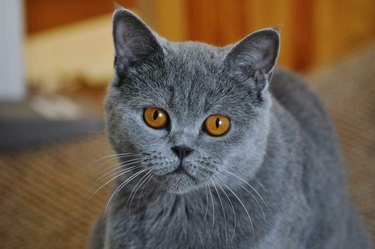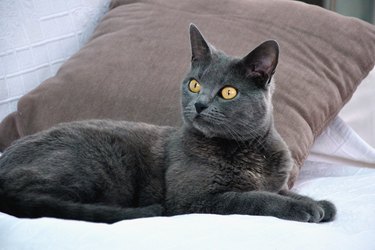
Chartreux cat quick facts
Length: 15 - 18 inches
Weight: Females: 6 - 9 pounds, Males: 10 - 17 pounds
Video of the Day
Video of the Day
Lifespan: 12 - 15 years
Coat length: Short
Coloring: Varying shades of blue-gray with pumpkin-colored eyes
Grooming needs: Medium
Friendliness: Breed alone is not an accurate predictor of individual cats' personalities. However, Chartreux cats are generally regarded as easygoing and loyal.
The Chartreux is the national cat of France. This type of cat is a fairly rare, but wonderful breed. If you are only looking at their coloring, you may mistake them for a Russian blue cat. However, there are many differences that quickly become apparent. Chartreux cats have a stocky build and thin legs earning them the nickname the cats "a potato on toothpicks." They have a thick, plush coat that can make them look even bigger.
If you are looking for a friendly, affectionate, and laid-back companion, a Chartreux kitten may be right for you. This cat breed is also quick and playful. Carefully consider the breed's personality and care requirements before bringing one into your home.

Chartreux cat history
The Chartreux cat breed is an ancient blue cat that has been referenced in literature as far back as the 16th century in France. Linnaeus and Buffon, two 18th-century naturalists, named the Chartreux as one of the four cat breeds known to them.
The origins of the breed are unknown, but there are a few theories and legends. One is that the cats were kept as companions in monasteries by the Carthusian monks, although there is no solid evidence of this. Some believe that the cats were brought to the French monasteries from Syria after the Crusades. While the cats are considered to be a French cat breed, some believe the breed got its name from a type of Spanish wool.
Much of the breed's population was lost during World War II, and Chartreux breeders revived the breed by outcrossing with other breeds, including blue Persians and British shorthair cats. General Charles de Gaulle, a French army officer during World War II, had a Chartreux cat.
The first Chartreux cats were imported into the United States in 1970 and in 1987, the breed was accepted into the Cat Fanciers' Association (CFA). Breeders in France and North America follow a unique naming convention for Chartreux kittens. All of the kittens born in a given year receive names that start with a given letter that is specific to the year. The letters K, Q, W, X, Y, and Z are not used.
Chartreux cat personality
These cats are best described as gentle and affectionate. They are calm and quiet and rarely vocalize and meow. They enjoy your company and make excellent companions. You can even travel with the cats as they tend to be quite adaptable to new situations. The breed may be a good choice if you have other pets or young children in the household.
They may have a laid-back attitude, but that doesn't mean they are lazy. They have muscular bodies and fast reflexes which makes them excellent mousers. They also greatly enjoy playtime and they love to climb and jump.
Chartreux cats are intelligent and can be described as dog-like in many ways. They enjoy interactive toys and will joyfully chase and jump in pursuit of a teaser toy. You can teach them to play fetch and come when called. Some cats have even learned to turn on lights and open doors.

Chartreux cat lifespan and health issues
Chartreux cats tend to be a very healthy breed that lives well into their teens. There are a few health problems that some cats may experience. These include:
- polycystic kidney disease: A condition that causes cysts in the kidneys and may eventually lead to kidney failure.
- patellar luxation: A condition in which the kneecap moves out of its normal position.
- bladder stones: A painful condition in which stones made of minerals form in the bladder causing irritation and potentially blocking the urethra.
Speak with the breeder about any health testing results prior to purchasing a Chartreux kitten.
Chartreux cat grooming and care
Chartreux cats may have short coats, but they require more grooming than some other shorthaired cat breeds. This is because they have a double coat with a thick undercoat.
At least once per week, make sure you comb all the way through the undercoat. It is easy to miss tangles near the skin that can eventually turn into matted fur. If matting does occur, do your best to gently pull apart and comb out the fur. If the matting is severe, take the cat to a veterinarian or professional groomer to have the mats removed.
Other regular grooming requirements include:
- checking and trimming the cat's nails
- cleaning the cat's ears
- brushing the cat's teeth with a toothpaste that is veterinarian-approved for pets
Feed high-quality commercial cat food in the amount recommended by your veterinarian. Weight gain and obesity are concerns for some adult cats, so avoid free feeding. Make sure the cat always has fresh drinking water available. Take the cat in for regular check-ups with your veterinarian and stay up-to-day with the recommended vaccinations.

Welcoming a new cat into your home
Before bringing a new Chartreux kitten or cat into your home, make sure you cat-proof the house to make it safe for the new cat. Remove any poisonous plants and put away any small breakable items that the cat may knock over when playing. The Chateaux cat loves to jump, so don't forget to cat-proof shelves and the top of the refrigerator and bookshelves.
Set up a single room where you can welcome your new cat and where they have a safe and quiet place to adapt to their new surroundings. Equip the room with everything your cat needs including:
- food and water dishes
- litter box
- cat toys
- scratching post
Allow your new cat to explore at their own pace. Don't force them into certain areas of the room or hold them to be petted before they are ready. Instead, use plenty of positive reinforcement. Allow the cat to come to you when they are ready. If you have other pets in the home, make introductions slowly. That way, both animals are safe and have a positive experience.
The Chartreux cat breed is known to be quite adaptable. With a bit of patience, your new cat will be an active member of the family — and a loving, affectionate companion.